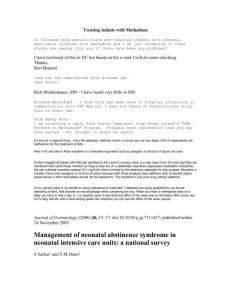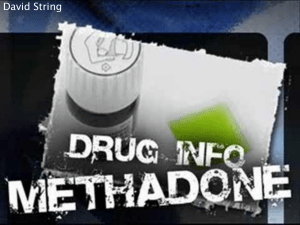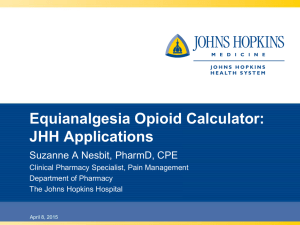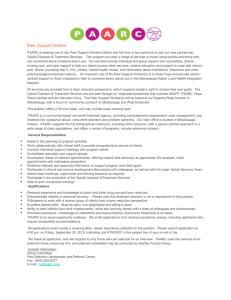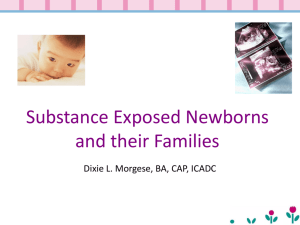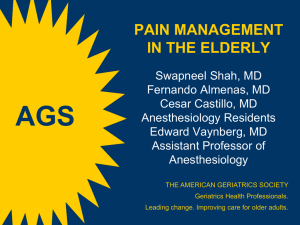Management of Neonatal Opioid Withdrawal
advertisement
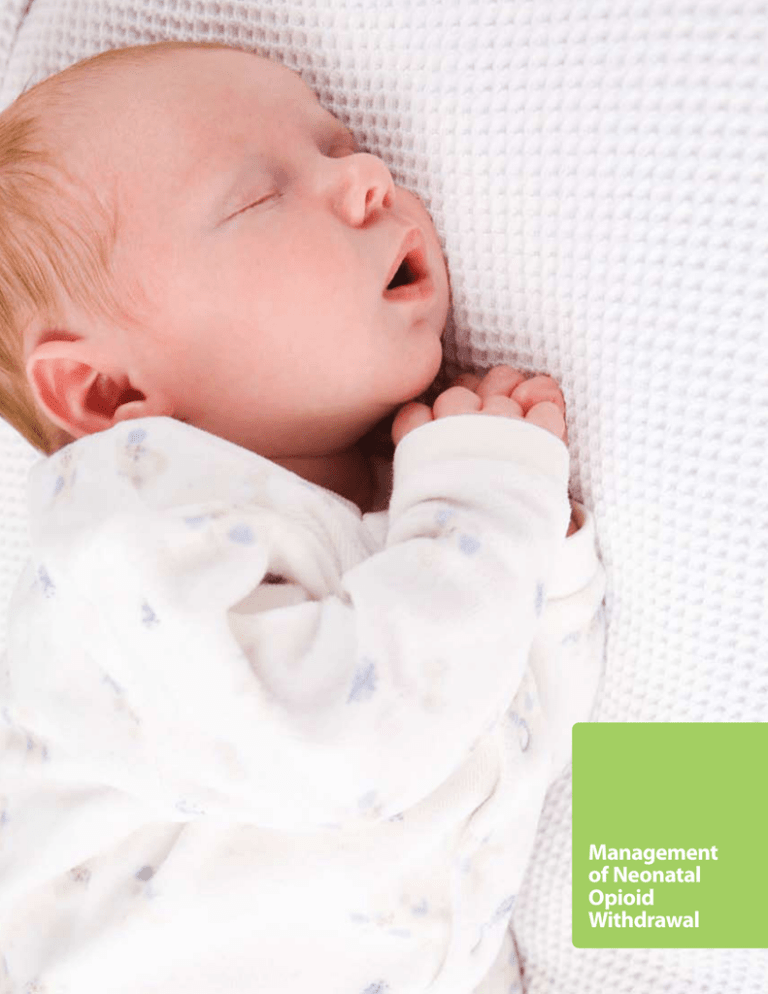
Management of Neonatal Opioid Withdrawal Neonatal Abstinence Syndrome Overview......................... 1 Opioid Addiction.......................................................................................... 1 Opioids and Pregnancy.............................................................................. 1 GUIDELINES FOR MANAGEMENT OF OPIOID-EXPOSED NEWBORNS..................................................................................................... 3 Site of Care for Opioid Exposed Newborns........................................ 3 Neonatal Abstinence Syndrome (Nas) Scoring............................... 3 Treatment........................................................................................................ 3 Screening........................................................................................................ 4 Breastfeeding................................................................................................. 4 Management of Infants Born to Hepatitis C Antibody Positive Women...................................................................................... 5 Discharge Considerations for Infants on Oral Methadone........... 5 Outpatient Management of Neonatal Opioid Withdrawal........... 5 Monthly Multidisciplinary Meetings..................................................... 5 Anne Johnston, MD Jerilyn Metayer, RN Elizabeth Robinson, PNP BIBLIOGRAPHY.............................................................................................. 6 Appendices Appendix 1: NAS Scoring Form............................................................... 7 Appendix 2: NAS Explanation.................................................................. 8 Appendix 3: Neonatal Medical Follow-up Clinic: Antenatal Consult Form...................................................................... 9 Appendix 4: Neonatal Medical Follow-up Clinic: Infant Visit.....11 Management of Neonatal Opioid Withdrawal Purpose/Disclaimer The Management of Neonatal Opioid Withdrawal was created to provide Vermont practitioners with the consolidated set of recommendations for the management of the opioid exposed newborn. The content is intended to complement standard medical care, the Vermont Buprenorphine Practice Guidelines, and other resources available through the American Academy of Pediatrics (www.aap.org), Substance Abuse and Mental Health Services Administration (www.samhsa.gov) and the Center for Substance Abuse Treatment (www.csat.samhsa. gov). These guidelines are not intended as requirements for practitioners. They should not be considered medical advice. Neonatal Abstinence Syndrome Overview Neonatal abstinence syndrome (NAS) refers to a constellation of signs in the newborn due to substance or medication withdrawal. In most cases, exposure occurs during pregnancy, but it may also describe a syndrome secondary to withdrawal of opioids and sedatives administered postnatally to infants with serious illness. Opioids (naturally occurring, synthetic and semi-synthetic) are the most frequent drugs which give rise to the typical signs. OPIOID ADDICTION Opioid use and dependence during pregnancy continues to be a significant public health problem. Data from the National Survey on Drug Use and Health indicate that the rate of heroin use by pregnant women has increased somewhat over time and there has been a 33% increase in non-medical use of analgesics in this population in the past decade (Substance Abuse and Mental Health Services Administration, 2006). Heroin (diacetylmorphine), a semisynthetic opioid with a rapid onset of action and a short half life, is one of the frequently used opioids during pregnancy. Although it is typically injected, an increasing number of users are inhaling or smoking heroin. The use of other opioids, including oxycodone, hydrocodone, and the controlled-release form of oxycodone (OxyContin®) has escalated in recent years. Acute use of heroin and other opioids stimulate the opiate receptors in the brain which may result in symptoms including euphoria, respiratory depression, analgesia, and nausea. Chronic use of opioids is associated with tolerance; higher doses of the drug are required to obtain the same effect. Tolerance leads to dependence, whereby the neurochemical balance in the central nervous system is altered and absence of the drug leads to a withdrawal syndrome. Opioid withdrawal is characterized by a constellation of symptoms including agitation, nasal congestion, yawning, diaphoresis, muscle cramps, diarrhea, nausea, vomiting, and depression. Several mechanisms have been proposed to explain the phenomena of tolerance, dependence and withdrawal in the setting of chronic opioid exposure. These include (1) increased metabolic breakdown of opioid compounds, (2) decreased neurotransmitter release resulting in an increased number and sensitivity of post-synaptic receptors, and (3) down-regulation of opioid receptors resulting in decreased production of endogenous endorphins. Due to these changes, some opioid dependent patients will need medication-assisted treatment for prolonged periods, possibly for the rest of their life. The standard of care for opioid-dependent patients is medication-assisted treatment with opioid-agonists in conjunction with counseling and supportive services. (US Department of Health and Human Services, Substance Abuse and Mental Health Services Administration, 1993). Methadone and buprenorphine are the most commonly prescribed medications for these patients. OPIOIDS AND PREGNANCY The cycle of opioid use and withdrawal is particularly devastating for the developing fetus. The repetitive pattern of use and withdrawal leads to fetal hypoxia and uteroplacental insufficiency with resultant increased risk of prematurity, fetal demise and low birth weight. Comprehensive prenatal care is essential for these patients. Medication-assisted treatment has been the standard of care for pregnant opioid-dependent patients. At appropriate dosages, methadone, a synthetic opioid, will eliminate symptoms and signs of withdrawal, reduce cravings, and block euphoric effects should supplemental opioids be used. The long half life and predictable dosing prevents erratic opioid levels in the fetus, and is associated with a longer duration of pregnancy and improved fetal growth. As the pregnancy progresses, methadone is metabolized more rapidly and higher doses are required. Although there were early reports suggesting that the dose of methadone correlated with the incidence and severity of neonatal withdrawal signs, recent evidence does not demonstrate such a relationship. (Berghella V, 2003) (McCarthy JJ. Leamon MH, 2005). It is well accepted that lowering the dose during pregnancy may lead to increased illicit drug use, thus exposing the mother and fetus to more harm. Buprenorphine, a partial opioid-agonist, has recently been approved by the United States Food and Drug Administration for the treatment of opioid addiction in an outpatient office setting. Although not yet approved for use in pregnancy, preliminary studies suggest that buprenorphine is associated with a decreased incidence of neonatal withdrawal when compared with methadone (Kakko J, 2008). In addition to the concern regarding withdrawal, the prevalence of hepatitis B, hepatitis C, and human immuno-deficiency virus (HIV) is elevated in pregnant Management of Neonatal Opioid Withdrawal opioid-dependent patients, primarily due to needle sharing and unsafe sexual practices. Women should be screened for these infections, and in the case of HIV infection, treatment should be initiated. The management of addiction in pregnancy is highly complex and attention must be focused not only on medication, but also to the complicated psychological and social needs of these women. A high number of these women have a history of domestic violence, are poorly educated, financially constrained, and have poor relationships with partners who may also be substance abusers. They frequently have dysfunctional families with a high prevalence of substance abuse and alcoholism. Many of these women have co-morbid psychiatric conditions, most commonly depression and bipolar disorder, and suffer from low self-esteem (Kaltenbach K, 1998). Neonatal Abstinence Syndrome: Clinical Presentation The newborn with opioid withdrawal presents with central nervous system excitability, vasomotor signs and gastrointestinal signs. The timing of onset of signs varies; however, infants exposed to heroin or other short-acting opiates will typically presents within the first 48–72 hours. Those exposed to methadone or buprenorphine will often present later, usually within the first 4 days. The infant is assessed using a standardized scoring system such as the system developed by Finnegan (1975, 1992) and since modified by Jansson (2009) and others which assesses signs of withdrawal. When scores are elevated, the infant may be a candidate for pharmacologic treatment. Newborn urine and meconium toxicology screens may aid in the diagnosis when the mother has not been in a treatment program. Urine testing generally reflects drug exposure within several days, depending upon the drug. Results of urine testing are rapidly available; however, there is a high false negative rate given the rapid clearance of most drugs and the difficulty in obtaining sufficient urine from a newborn in the first day of life. Meconium testing offers the advantage of assessing drug exposure during the previous several months. However, meconium test results are frequently not available for several days, at which time the infant may have been discharged. The differential diagnosis should include sepsis, hypoglycemia, hypocalcemia, hypomagnesemia, hyperthyroidism, perinatal asphyxia, and intracranial hemorrhage. Recent maternal serologies for hepatitis B, hepatitis C and HIV should be determined. Treatment Approximately 50–75 percent of infants born to women on opioids will require treatment for opioid withdrawal. At the delivery of a known opioid-dependent woman, naloxone should be avoided in resuscitation of the infant as it may precipitate seizures. Management of Neonatal Opioid Withdrawal Supportive care is essential in the management of infants exhibiting signs of withdrawal. Decreased stimulation, swaddling, and frequent feedings on demand are beneficial. Infants may require intravenous fluids to maintain hydration. Caloric expenditure is frequently elevated, and therefore increasing the caloric density of feeds may be indicated. Pharmacologic therapy is indicated for infants with increasing severity of signs and in cases of significant vomiting, diarrhea, or excessive weight loss. Infants may be treated with a variety of medications including shortacting opioids such as morphine sulfate and long-acting opioids such as methadone (AAP Committee on Drugs. Neonatal Drug Withdrawal. Pediatrics 1998;101;1079-1088). Methadone may be continued and weaned as an outpatient whereas morphine sulfate should be restricted to hospitalized infants and weaned completely prior to discharge home. Women on methadone or buprenorphine maintenance therapy are encouraged to breastfeed their infants, providing they are HIV negative (McCarthy J, 2000) (Substance Abuse and Mental Health Services Administration, Treatment Improvement Protocols, 2004). Discharge Considerations The opioid-dependent new mother undergoes significant stress during the post partum period. A comprehensive discharge plan that addresses maternal substance abuse treatment, a safe environment, parenting and community support are essential. Guidelines for Management of Opioid-Exposed Newborns at Vermont Children’s Hospital at Fletcher Allen Health Care SITE OF CARE FOR OPIOID-EXPOSED NEWBORNS •Infants not requiring pharmacologic treatment: Newborn Nursery •Infants at the initiation of pharmacologic treatment: Neonatal Intensive Care Unit (NICU), or Neonatal Transitions Suite (NTS), (since the Fletcher Allen nursery does not have cardiopulmonary monitors) •Infants on a stable methadone dose may be transferred to Newborn Nursery prior to discharge •Infants on morphine sulfate need to remain in NICU or NTS (where monitoring available) NEONATAL ABSTINENCE SYNDROME (NAS) SCORING • Use modified Finnegan Neonatal Abstinence Scoring Sheet.* (See Appendix 1, Adapted from L. Jansson, 2009) • NAS score at 2 hours of age and every 3–4 hours thereafter; continue scoring for the duration of hospitalization (minimum of 96 hours). Do not wake infant for score unless the interval >6 hours •Initial treatment consists of providing a supportive environment (decrease sensory stimulation; implement changes in positioning, skin-to-skin (kangaroo care), swaddling, pacifier) • NAS scoring should occur in the mother’s room, whenever possible •Score infant before feeding • NAS score <9, continue NAS scoring in Newborn Nursery • NAS score ≥9 attempt to feed and score within 1 hour; if both scores ≥9, notify attending physician for evaluation and possible transfer to NICU/NTS TREATMENT •If infant has 2 consecutive scores (e.g. before and after feed) of ≥9 with no confounding variables, consider pharmacologic treatment •Continue to provide a supportive environment (decrease sensory stimulation; implement changes in positioning, skin-to-skin (kangaroo care), swaddling, pacifier) •If infant meets criteria for pharmacologic treatment, the infant should be treated with methadone Treatment Choice: Short-acting Opioid or Methadone? •Community hospitals should treat infants with shortacting agents such as morphine sulfate or dilute tincture of opium and wean the infant completely off medication prior to discharge •Most hospitals treat NAS with short acting morphine sulfate (Sarkar & Donn, 2006) •At this time, community hospitals do not have the infrastructure necessary for treating infants with methadone as outpatients •The treatment of choice for infants with NAS at Fletcher Allen is methadone, which allows for a shorter hospital stay but more intensive outpatient management • Fletcher Allen infants who are to be discharged to an area where outpatient methadone management is unavailable and cannot come to biweekly appointments at Fletcher Allen should be treated with morphine sulfate •Infants who can be back-transferred to hospital that has a program for inpatient treatment of NAS with morphine sulfate may be treated with morphine sulfate Morphine Sulfate •If infant has 2 consecutive scores (e.g. before and after feed) of ≥9, start morphine treatment at a dose corresponding to the highest score •Administer morphine sulfate orally as follows: ScoreMorphine Initial Dose 9–12 0.04 mg 13–16 0.08 mg 17–20 0.12 mg 21–24 0.16 mg >24 0.20 mg •If infant’s symptoms are not controlled by the above protocol (i.e., requires > 0.20 mg morphine sulfate solution every 3 hours), or if infant appears somnolent or difficult to rouse, notify treating nurse practitioner or physician immediately •Continue morphine sulfate at initial dose every 3–4 hours with feeds • NAS score ≥ 9: increase the dose as follows: ScoreMorphine New Dose 9–12 Previous dose + 0.02 mg 13–16 Previous dose + 0.04 mg 17–20 Previous dose + 0.06 mg 21–24 Previous dose + 0.08 mg >24 Previous dose + 0.1 mg •When NAS score remains <9 for 48 hours, start weaning dose by 0.02 mg every 24 hours until discontinued •Infant may be discharged when off morphine for 24 hours with score <9 •Maximum interval for NAS scoring and morphine dosing is 4 hours while on treatment • Note: for any score between 9 and 12, consider repeating the score after a feed before acting upon it Management of Neonatal Opioid Withdrawal Methadone Treatment at Fletcher Allen Health Care •Starting dose: 0.3 mg po q12 hours (range of 0.3–0.6 mg po q12 hours depending upon severity of signs) •If scores are ≥9 after first dose, consider giving an extra dose of 0.3 mg of methadone (independent of the regular doses which should continue) •If scores are ≥9 after 4 scheduled doses, consider increasing dose by 0.05–0.2 mg •Most infants will not need more than 0.5 mg po q12 hours •When scores are < 9 for 24–48 hours on a stable methadone dose, may discharge home •If infant is somnolent, does not rouse spontaneously for feeds, or has abnormal eye movements, discontinue methadone immediately and continue scoring. If or when scores approach 7 or greater, restart methadone at lower dose using following guide: • No methadone dose for 24 hours: decrease by 0.05 mg • No methadone dose for 36 hours: decrease dose by 0.1 mg • No methadone dose for 48 hours: decrease dose by 0.15 mg • No methadone dose for 72 hours: decrease dose by 0.2–0.25 mg •If methadone is not needed by 96 hours and there are no significant signs of withdrawal, discharge infant •Infant should remain on cardiorespiratory monitoring and/or pulse oximetry until stable dose is achieved and somnolence has resolved SCREENING •Infants born to mothers in stable recovery through a drug treatment program (e.g.: methadone or buprenorphine) do not necessarily require testing, particularly if the mother’s urine screens have been negative. For infants born to women with a suspected history of drug abuse during pregnancy, no prenatal care or abruption, consider urine and meconium toxicology testing. • Newborn urine drug screening: (if indicated) •Samples should be collected within the first 24–48 hours of life •Standard urine toxicology screen (Drug screen compensate): amphetamines, barbiturates, benzodiazepines, cocaine, cannabinoids, and selected opioids •Opioids which are not detected by the standard screen may include methadone, buprenorphine and oxycodone Management of Neonatal Opioid Withdrawal • Newborn meconium drug screening: •Samples may be collected during the first 3–4 days of life until stools become transitional •Standard meconium toxicology screen (MECDG): amphetamines, opioids, and metabolites of cocaine and marijuana •Confirmatory testing is available BREASTFEEDING •Breastfeeding is recommended for all infants unless mother is HIV positive •Maternal hepatitis C and hepatitis B are not contraindications •Methadone •Very small amounts of methadone are transmitted through breast milk even at doses of 250 mg daily, therefore maternal methadone is not a contraindication to breastfeeding (McCarthy J, 2000) •Buprenorphine •Safe for breastfeeding (Substance Abuse and Mental Health Services Administration, Treatment Improvement Protocols, 2004) •If infant is on opioid treatment for NAS, mother should remain on Subutex® MANAGEMENT OF INFANTS BORN to HEPATITIS C ANTIBODY POSITIVE WOMEN General The overall rate of mother-to-infant HCV transmission is in the range of 1.0%-5.0% (Yeung, 2001) Recommendations for Testing Testing for infants born to infected mothers should be done at 18 months of age (American Academy of Pediatrics 2009) Laboratory Test: Hepatitis C Antibody Follow Up Plan for Hepatitis C Positive Infants: • Notify Primary Care Provider • Notify family • Provide written information • Hepatitis A vaccine recommended •Refer to Pediatric Gastroenterology If Diagnosis is Needed Sooner than 18 Months of Age: • Qualitative RNA PCR testing to detect HCV RNA may be performed at or after the infant’s first well-child visit at 1–2 months of age (American Academy of Pediatrics 2009) DISCHARGE CONSIDERATIONS FOR INFANTS ON oral METHADONE • Family/caregiver to receive education regarding storage and administration of methadone •Methadone prescription is written for 3–4 weeks supply • Neonatal Medical Follow-up appointment within 1 week of discharge • Family/caregiver instructed to bring methadone to every neomedical clinic visit OUTPATIENT MANAGEMENT OF NEONATAL OPIOID WITHDRAWAL Methadone Taper • Family/caregiver, with a syringe and air demonstrates the amount of methadone they are administering to the infant at every clinic visit • Family should demonstrate (with syringe and air) at least 2 scheduled wean amounts •Wean by 0.02–0.05 mg per dose, either weekly on Mondays, or twice weekly on Mondays and Thursdays as indicated •On patient instruction sheet, wean plan is clearly written with a copy in the clinic chart •If family or health care providers are concerned about signs of withdrawal, a call is made to the Neonatal Medical Follow Clinic prior to any change in dosing •When a dose of 0.02–0.05 mg twice a day is tolerated for 3–7 days, then that dose is administered once daily for 3–7 days, and then discontinued MONTHLY MULTIDISCIPLINARY MEETINGS •ChARM (Children and Recovering Mothers) Patient Care Meeting occurs monthly •Members are impaneled; facilitated by KidSafe Collaborative • Participants: Addiction Physician Obstetrician (MFM) Neonatologist Social Worker (OB clinic) Nurse Clinician (NeoMed) VNA Nurse NP methadone clinic NP (NeoMed ) DCF intake supervisor Representative DOC Lund Family Center Nurse (OB Clinic) Social Worker (inpatient) Public Health Nurse Representative from ADAP Neonatal Medical Follow-Up Clinic • Q 1–2 week visits while infant on methadone • Q 1–2 month visits for infants not on methadone • Family to bring methadone to every clinic appointment •Developmental screening at 8–10 months of age • Follow-up to continue until 12–18 months of age •If a patient does not show for appointment the nurse clinician attempts to contact family and reschedule appointment •If unable to contact family, the Primary Care Provider is notified Management of Neonatal Opioid Withdrawal BIBLIOGRAPHY Finnegan Neonatal Abstinence Scoring (Finnegan LP, Kaltenbach K. Neonatal abstinence syndrome. In Hoekelman RA, Friedman SB, Nelson NM, et al., Primary Pediatric Care. 2nd ed. St. Louis: Mosby, 1992:1367-78) Jansson LM, Velez M, Harrow C. The opioid-exposed newborn: assessment and pharmacologic management. J Opioid Manag 2009;5:47-55. Jones HE, et al. Buprenorphine versus methadone in the treatment of pregnant opioid-dependent patients: Effects on the neonatal abstinence syndrome. Drug Alcohol Depend 2005;79:1-10. D’Apolito K. A scoring system for assessing neonatal abstinence syndrome [video tapes and manual]. Seattle: University of Washington, School of Nursing, 1994. American Academy of Pediatrics. [Hepatitis C]. In: Pickering LK, Baker CJ, Kimberlin DW, Long SS, eds. Red Book: 2009 Report of the Committee on Infectious Diseases. 28th ed. Elk Grove Village, IL: American Academy of Pediatrics; 2009:[357-360] American Academy of Pediatrics, Provisional Committee on Substance Abuse. (1998). Drug-Exposed Infants. Pediatrics , 101 (6), 1079-1088. Berghella V, L. P. (2003). Maternal methadone dose and neonatal withdrawal. Amercian Journal of Obstetrics and Gynecology, 189, 312. Finnegan, L. (1975). Neonatal abstinence syndrome: assessment and management. Addictive Diseases International Journal, 2, 141-158. Jansson L, V. M. (2009). The opioid exposed newborn: assessment and pharmacologic management. J Opioid Manag, 5 (1), 47-55. Kakko J, H. M. (2008). Buprenorphine and methadone treatment of opiate dependence in pregnancy: Comparison of fetal growth and neonatal outcomes in two consecutive case series. Drug and Alcohol Dependence, 96 (1-2), 69-78. Kaltenbach K, B. V. (1998). Opioid dependence during pregnancy. Effects and Management. Obstet Gynecol Clin North Am, 25, 139. McCarthy J, P. B. (2000). Methadone levels in human milk. J Hum Lact, 16, 115-120. McCarthy JJ. Leamon MH, P. M. (2005). High-dose methadone maintenance in pregnancy: Maternal and neonatal outcomes. American Journal of Obstetrics and Gynecology, 193, 606. Management of Neonatal Opioid Withdrawal Substance Abuse and Mental Health Services Administration. (2006). National Survey on Drug Use and Health. Substance Abuse and Mental Health Services Administration, Treatment Improvement Protocols. (2004). Clinical Guidelines for the Use of Buprenorphine in the Treatment of Opioid Addiction, TIP 40. Rockville: DHHS. US Department of Health and Human Services, Substance Abuse and Mental Health Services Administration. (1993). Improving Treatment for Drug Exposed Infants: Treatment Improvement Protocol (TIP) Series 5. Rockville: DHHS Publication. Yeung, K. R. (2001). Mother to infant transmission of hepatitis C virus. Hepatology, 34 (2), 223-229. Appendix 1: Neonatal Abstinence Syndrome Scoring Form MRN NameDOB SIGNS Observations from past 3–4 hours. Start new scoring sheet each calendar day. Birth Weight: __________ grams (x 90% = _________ grams) Daily Weight: __________ grams Date:ScoreTimeTimeTimeTimeTimeTimeTimeTime High pitched cry: inconsolable >15 sec. 2 OR intermittently for <5 min. High pitched cry: inconsolable >15 sec. 3 AND intermittently for ≥5 min. Sleeps <1 hour after feeding 3 Sleeps <2 hours after feeding 2 Sleeps <3 hours after feeding 1 Hyperactive Moro 1 Markedly hyperactive Moro 2 Mild tremors: disturbed 1 Moderate–severe tremors: disturbed 2 Mild tremors: undisturbed 1 Moderate–severe tremors: undisturbed 2 Increased muscle tone 1–2 Excoriation (indicate specific area): 1–2 ________________________________ Generalized seizure 8 Fever ≥37.2°C (99°F) 1 Frequent yawning (≥4 in an interval) 1 Sweating 1 Nasal stuffiness 1 Sneezing (≥4 in an interval) 1 Tachypnea (rate >60/min.) 2 Poor feeding 2 Vomiting (or regurgitation) 2 Loose stools 2 ≤90% of birth weight 2 Excessive irritability 1–3 Total score Initials of scorer Printed Name Signature/Title Initials Printed Name Signature/Title Initials Jansson LM, Velez M, Harrow C. The opioid-exposed newborn: assessment and pharmacologic management. J Opioid Manag 2009;5:47-55. Management of Neonatal Opioid Withdrawal Appendix 2: Neonatal Abstinence Syndrome (NAS) Scoring Explanation Definitions were adapted from the MOTHER study (NCT00271219) and (D’Apolito 1994). Assessment & Documentation Sweating •The infant is scored at 2 hours of age and every 3-4 hours prior to a feeding •The NAS score will be recorded for the 3-4 hour period immediately before the scoring activity •Signs and symptoms are documented on the NAS form and totaled for a score •Wetness felt on the infant’s forehead, upper lip (Score = 1) •Sweating on the back of the neck may be from overheating such as swaddling Sleeping Nasal Stuffiness •Any nasal noise when breathing (Score = 1) •Runny nose may or may not be present • For every sign except sleeping, a score of 0 = not present • Use the longest single continuous time sleeping since last feeding •Sleeps 3 or more hours continuously (Score = 0) •Sleeps 2-3 hours after feeding (Score = 1) •Sleeps 1-2 hours after feeding (Score = 2) •Sleeps less than 1 hour after feeding (Score = 3) •When repeating a score within 1 hour after a feeding: use the same sleep score obtained before the feeding. Sneezing Moro Reflex Nasal Flaring •Cup infant’s head in your hand and raise his/her head about 2-3 inches above the mattress, then drop your hand while holding the infant. •The infant should be quieted if irritability or crying is present. This will insure that the jitteriness, if present, is due to withdrawal rather than agitation. • Hyperactive Moro: arms stay up 3-4 sec with our without tremors (Score = 1) •Markedly Hyperactive Moro: arms stay up > 4 sec with or without tremors (Score = 2) Tremors •Tremors = jitteriness •Involuntary movements that are rhythmical •If the infant is asleep, it is normal to have a few jerking movements of the extremities •Mild tremors: hands or feet only, last up to 3 seconds (Score = 1) •Moderate-severe tremors: arms or legs, last more than 3 seconds (Score = 2) • Undisturbed: tremors that occur in the absence of stimulation Increased Muscle Tone •While the infant is lying supine, extend and release the infant’s arms and legs to observe for recoil •Infant supine, grasp arms by wrists and gently lift infant, looking for head lag •Difficult to straighten arms but is possible, and head lag is present (Score = 1) • No head lag noted or arms or legs won’t straighten (Score = 2) Excoriation •Red or broken skin from excessive rubbing (eg: extremities or chin against linens) •Skin red but intact or is healing and no longer broken (Score = 1) •Skin breakdown present (Score = 2) Management of Neonatal Opioid Withdrawal •Infant sneezes 4 or more times in the scoring interval of 3–4 hours (Score = 1) Tachypnea •The infant must be quieted if crying first; count respirations for full minute •Respiratory rate > 60/min (Score = 2) •Outward spreading of the nostrils during breathing (Score = 1) Poor Feeding Poor feeding is defined as any 1 of the following (Score = 2) •Infant demonstrates excessive sucking prior to a feeding yet sucks infrequently while feeding and takes a small amount of formula/ breast milk •Demonstrates an uncoordinated sucking reflex (difficulty sucking and swallowing) •Infant continuously gulps while eating and stops frequently to breathe •Inability to close mouth around bottle/breast • Feeding takes more than 20 minutes Regurgitation/Vomiting • Frequent regurgitation (vomits whole feeding or vomits 2 or more times during feed) not associated with burping (Score = 2) Loose Stools •Infant has a stool that is at least half liquid (Score = 2) •When repeating a score within 1 hour after a feeding: use the same stool score obtained before the feeding. Current Weight ≤ 90% of Birth Weight •Infant is weighed once a day and then that score is carried through the rest of the day •Weight is ≤ 90% of birth weight (Score = 2) •Continue to score until infant gains weight and is > 90% of birth weight • Use workspace at top of form Excessive Irritability •Distinct from, but may occur in conjunction with crying •Marked by frequent grimacing, excessive sensitivity to sound and light •Infant becomes fussy or irritable with light, touch or handling despite attempt to console •Consoling calms infant in 5 minutes or less (Score = 1) •Consoling calms infant in 6-15 minutes (Score = 2) •Consoling takes more than 15 minutes or no amount of consoling calms infant (Score = 3) Appendix 3: Neonatal Medical Follow-up Clinic: Antenatal Consult Form consult requested by G T age p HepC Ab__________ a L HIV___________ Blood type________ VDRL_________ Ab screen________ GC/Chl_________ edc Rubella________ lmp Vancelia________ Mult markers_________ HepB________ Other______________________ Gest@presentation Accompanied by Past medical history: Family history: Previous pregnancies: Current pregnancy: Drug history: Rehab: Drug use during pregnancy (including alcohol and tobacco): Current medications: Management of Neonatal Opioid Withdrawal Living situation: Father of baby: Highest level of education: Occupation: Goals and aspirations: DOC history: DCF history: Home health nurse: Counselor: Substance abuse treatment: Probation / Parole Officer: Name of baby: Breastfeeding plans: Pediatrician: Recommendations: Plan: signature 10 Management of Neonatal Opioid Withdrawal Appendix 4: Neonatal Medical Follow-up Clinic: Infant Visit Patient: Last name First NameDOB Date of visit time referring MD diagnosis age Child accompanied by: Interval History / Hospitalizations: Withdrawal Signs: Details: Methadone: mg, po, /day Parent/Guardian dose demonstration Last wean: Current wean plan: Methadone dosing times (approx.): Amount of remaining methadone in syringe/bottle: mls Respiratory: Feeding: Bowel Habits: Development: Services (Home Health, FITP, PT, OT, Nutrition, Eyes, Hearing): Social History: Maternal Medication:Dose: Frequency: Past Medical History: Family History: Medications: Immunizations (Flu / Synagis® if applicable): Review of Systems: Negative PositiveComments General Eyes ENT Respiratory GI GU Neuro Extremities Skin Behavior Management of Neonatal Opioid Withdrawal 11 Physical Examination: Wt___________kg (___________%) Wt for Length____________% Pain: No Findings HR____________ L___________cm (___________%) RR____________ SpO2____________ HC___________cm (___________%) FiO2____________ BP____________ Yes NormalAbnormalComments General HEENT Chest CVS Abdomen GU Neuro Extremities Skin Other Labs: Radiology: Assessment: Med:___________ Dose:___________ Route:___________ Time:___________ Plans/Recommendations: MethadoneVolume prescribed: Other medications: Feeds: Referrals: Next appoint: Other: Education: Method: Handout Demonstration Verbal Caregiver Other Taught to: Family Barriers: None Other Outcomes: Independent Other 12 Management of Neonatal Opioid Withdrawal Signature:______________________________________ Although this work product was funded in whole or in part with monies provided by or through the State of Vermont, the State does not necessarily endorse the researchers’ findings and/or conclusions. The findings and/or conclusions may be inconsistent with the State’s policies, programs, and objectives.

